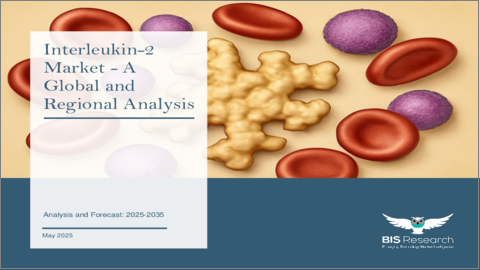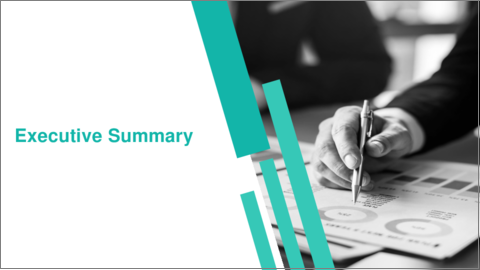|
|
市場調査レポート
商品コード
1737973
インターロイキン-2の世界市場:地域別の分析・予測 (2025-2035年)Interleukin-2 Market - A Global and Regional Analysis: Analysis and Forecast, 2025-2035 |
||||||
カスタマイズ可能
|
|||||||
| インターロイキン-2の世界市場:地域別の分析・予測 (2025-2035年) |
|
出版日: 2025年05月30日
発行: BIS Research
ページ情報: 英文 100 Pages
納期: 1~5営業日
|
全表示
- 概要
- 図表
- 目次
インターロイキン-2 (IL-2) は、免疫系において極めて重要な役割を果たすサイトカインであり、免疫応答に不可欠な白血球の一種であるT細胞の増殖と分化を促進します。
IL-2には、特にがん免疫療法や自己免疫疾患の治療において大きな治療応用の可能性があります。IL-2をベースとした治療法の市場は、免疫腫瘍学の進展、免疫調節に関する研究の拡大、サイトカイン治療の重要性の再評価を背景に進化を遂げています。これまでにFDAの承認を受けたAldesleukin (Proleukin) などのIL-2療法は、転移性黒色腫や腎細胞がん (RCC) の治療に使用され、がん免疫療法の分野で重要なマイルストーンとなってきました。近年では、新しい製剤や標的型IL-2療法が登場しており、さまざまながんや自己免疫疾患において治療効果の向上が期待されています。
世界のIL-2市場は、サイトカインに基づく治療の進歩、がん免疫療法における用途の拡大、および免疫調節治療に対する需要の増加により、着実に成長しています。がん治療におけるIL-2の役割と慢性自己免疫疾患の管理におけるIL-2の可能性は、IL-2を現代の医学研究と医薬品開発における重要な焦点分野にしています。
市場の主要な成長要因の一つは、がんの罹患率の上昇です。黒色腫、腎細胞がん、固形がんの増加により、世界のがんの負担は増加し続けています。IL-2は、これらの従来の化学療法では治療が困難だったがんに対して免疫応答を改善する効果が示されています。そのため、がんの発症が増加する中で、革新的ながん免疫療法、特にIL-2ベースの治療法に対する需要が拡大しています。
さらに、免疫療法の研究開発への大規模な投資も、IL-2市場の力強い成長を後押ししています。製薬企業や研究機関は、より効果的で安全性の高いIL-2治療法の開発に多くの資源を投入しており、これは免疫腫瘍治療が困難ながんの管理において有効性を示していることに対する認識の高まりに基づいています。また、FDAやEMAなどの政府・規制当局もIL-2治療を含む免疫療法の開発と承認を積極的に支援しており、市場拡大の追い風となっています。例えば、他の免疫療法との併用を目的とした新たなIL-2系治療薬NKTR-214の承認は、がん患者に対する持続的な治療効果を目指す新世代の治療法として、さらなる市場の拡大を加速させています。
当レポートでは、世界のインターロイキン-2の市場を調査し、主要動向、市場影響因子の分析、法規制環境、臨床試験の動向、市場規模の推移・予測、各種区分・地域/主要国別の詳細分析、競合情勢、主要企業のプロファイルなどをまとめています。
目次
エグゼクティブサマリー
第1章 世界のインターロイキン-2市場:業界の展望
- 市場動向
- 規制の枠組み
- 臨床試験分析
- 市場力学
- 影響分析
- 市場促進要因
- 市場の課題
- 市場機会
第2章 世界のインターロイキン-2市場:地域別
- 北米
- 欧州
- アジア太平洋
- 主な調査結果
- 市場力学
- 市場規模・予測
第3章 世界のインターロイキン-2市場:競合情勢と企業プロファイル
- 主要な開発と戦略
- M&A
- 相乗的な取り組み
- 事業拡大と資金調達
- 製品の発売と承認
- その他の活動
- 企業プロファイル
- Bristol Myers Squibb
- Sanofi S.A.
- Corvus Pharmaceuticals
- Regeneron Pharmaceuticals
- Merck & Co., Inc.
- F. Hoffmann-La Roche AG
- Cue Biopharma
第4章 調査手法
List of Figures
- Figure: Global Interleukin-2 Market (by Region), $Million, 2024 and 2035
- Figure: Global Interleukin-2 Market Key Trends, Impact Analysis,
List of Tables
- Table: Global Interleukin-2 Market Dynamics, Impact Analysis
- Table: Global Interleukin-2 Market (by Region), $Million, 2023-2035
Global Interleukin-2 Market, Analysis and Forecast: 2025-2035
Interleukin-2 (IL-2) is a cytokine that plays a crucial role in the immune system by promoting the growth and differentiation of T cells, a type of white blood cell that is essential for immune responses. IL-2 has significant therapeutic applications, particularly in cancer immunotherapy and autoimmune diseases. The market for IL-2-based therapies has been evolving, driven by advancements in immuno-oncology, increased research into immune modulation, and the growing recognition of the importance of cytokine-based therapies in treating various conditions. Historically, IL-2 therapies such as Aldesleukin (Proleukin), approved by the FDA, have been used primarily for treating metastatic melanoma and renal cell carcinoma (RCC), marking significant milestones in immunotherapy. However, newer formulations and targeted IL-2 therapies are emerging, offering the potential to improve outcomes in various cancers and autoimmune disorders.
The global IL-2 market is growing steadily, fueled by advancements in cytokine-based treatments, expanding applications in cancer immunotherapy, and the increasing demand for immunomodulatory treatments. IL-2's role in cancer treatment and its potential in managing chronic autoimmune diseases make it a vital area of focus in modern medical research and pharmaceutical development.
One of the key drivers of the market is the rising prevalence of cancer. The global cancer burden continues to rise, with increasing rates of melanoma, renal cell carcinoma, and solid tumors. IL-2 has been shown to improve the immune response in cancers that are traditionally hard to treat with standard chemotherapy. As cancer incidence increases, there is a growing demand for innovative immunotherapies, including IL-2-based treatments.
Moreover, the IL-2 market is experiencing robust growth due to significant investments in immunotherapy research. Pharmaceutical companies and research institutions are pouring resources into the development of more effective and safer IL-2 therapies. This investment is driven by the increasing recognition of the effectiveness of immuno-oncology treatments in treating cancers that were previously difficult to manage. In addition, governments and regulatory bodies, such as the FDA and EMA, are offering more support for the development and approval of immunotherapies, including IL-2 treatments. The approval of new IL-2-based therapies such as NKTR-214 for use in combination with other immunotherapies has further propelled the market, as these therapies aim to provide more durable responses for cancer patients.
Despite the promising potential of IL-2 therapies, their high cost remains a significant barrier to widespread adoption. Aldesleukin (Proleukin), for example, is expensive, and while newer engineered IL-2 treatments may offer better outcomes, they come with high price tags that limit their accessibility, particularly in developing regions or for patients without insurance coverage. Also, high-dose IL-2 therapy is associated with severe side effects, including fever, chills, nausea, hypotension, and organ toxicity. These side effects can deter patients from undergoing treatment and limit the overall efficacy of IL-2-based therapies, especially in the long term. Efforts are ongoing to engineer IL-2 variants that retain efficacy while minimizing toxicities, but the challenge remains a restraint on market growth.
The global Interleukin-2 (IL-2) market is evolving rapidly, with major pharmaceutical companies and emerging biotech firms driving innovation. The market is highly fragmented, with significant ongoing research into expanding IL-2's use in treating cancer and autoimmune disorders such as lupus and multiple sclerosis. Companies are increasingly focusing on improving patients' quality of life by addressing immune-related issues alongside disease treatment, marking a transformative phase for the IL-2 market.
The Interleukin-2 (IL-2) market is undergoing significant transformation, driven by emerging trends in immunotherapy and advancements in biotechnology. One of the key trends is the increasing focus on personalized medicine, where IL-2 treatment plans are being tailored to individual patients' genetic profiles, disease progression, and immune system responses. With a deeper understanding of the molecular mechanisms behind diseases such as cancer and autoimmune disorders, biotech companies are investing in genetic research and biomarkers to identify which patients are most likely to benefit from IL-2-based therapies. This personalized approach has the potential to optimize treatment outcomes, minimize side effects, and improve overall patient well-being.
Another major trend is the growing demand for engineered IL-2 therapies that are more targeted and effective compared to traditional formulations. Engineered IL-2s such as NKTR-214 (bempegaldesleukin) are designed to enhance the selective activation of the immune system, particularly in tumor environments. These therapies have shown promising results in clinical trials, especially when combined with checkpoint inhibitors such as PD-1/PD-L1 inhibitors. IL-2-based combination therapies are gaining traction in oncology, especially for the treatment of solid tumors, where traditional therapies have shown limited success. Additionally, there is increasing interest in non-cancerous applications of IL-2, including its potential for managing autoimmune diseases such as systemic lupus erythematosus (SLE) and multiple sclerosis.
As healthcare access expands globally, the demand for IL-2 therapies is expected to rise, particularly in emerging markets where immunotherapy treatments are becoming more accessible. Pharmaceutical companies are focusing on improving affordability through patient assistance programs, pricing strategies, and distribution partnerships. These efforts aim to make IL-2-based therapies more widely available, especially in low- and middle-income regions, where the demand for effective treatments for cancer and autoimmune diseases is increasing. Furthermore, the rise of digital health tools and telemedicine platforms is enhancing the management of IL-2 therapies. These tools allow healthcare providers to remotely monitor patient responses, adjust treatment regimens, and ensure better patient adherence, particularly in long-term treatment scenarios.
In conclusion, the Interleukin-2 (IL-2) market is poised for continued growth, driven by innovations in engineered IL-2 therapies, personalized medicine, and increased access to cutting-edge treatments worldwide. While challenges such as the high cost of biologic therapies and side effects persist, ongoing research into more targeted and safer IL-2 therapies offers hope for improved treatment outcomes. With increasing global healthcare access, the market is positioned for expansion, especially as IL-2 therapies are incorporated into combination treatments and new therapeutic areas, such as autoimmune diseases. As innovation continues, both large pharmaceutical companies and emerging biotech firms will fuel competition, ultimately improving the quality of life for patients undergoing IL-2-based treatments.
Table of Contents
Executive Summary
Scope and Definition
Market/Product Definition
Inclusion and Exclusion
Key Questions Answered
Analysis and Forecast Note
1. Global Interleukin-2 Market: Industry Outlook
- 1.1 Introduction
- 1.2 Market Trends
- 1.3 Regulatory Framework
- 1.4 Clinical Trial Analysis
- 1.5 Market Dynamics
- 1.5.1 Impact Analysis
- 1.5.2 Market Drivers
- 1.5.3 Market Challenges
- 1.5.4 Market Opportunities
2. Global Interleukin-2 Market, by Region, $Million, 2023-2035
- 2.1 North America
- 2.1.1 Key Findings
- 2.1.2 Market Dynamics
- 2.1.3 Market Sizing and Forecast
- 2.1.3.1 North America Interleukin-2 Market, by Country
- 2.1.3.1.1 U.S.
- 2.1.3.1 North America Interleukin-2 Market, by Country
- 2.2 Europe
- 2.2.1 Key Findings
- 2.2.2 Market Dynamics
- 2.2.3 Market Sizing and Forecast
- 2.2.3.1 Europe Interleukin-2 Market, by Country
- 2.2.3.1.1 Germany
- 2.2.3.1.2 U.K.
- 2.2.3.1.3 France
- 2.2.3.1.4 Italy
- 2.2.3.1.5 Spain
- 2.2.3.1 Europe Interleukin-2 Market, by Country
- 2.3 Asia Pacific
- 2.3.1 Key Findings
- 2.3.2 Market Dynamics
- 2.3.3 Market Sizing and Forecast
- 2.3.3.1 Asia Pacific Interleukin-2 Market, by Country
- 2.3.3.1.1 Japan
- 2.3.3.1 Asia Pacific Interleukin-2 Market, by Country
3. Global Interleukin-2 Market: Competitive Landscape and Company Profiles
- 3.1 Key Development and Strategies
- 3.1.1 Mergers and Acquisitions
- 3.1.2 Synergistic Activities
- 3.1.3 Business Expansions and Funding
- 3.1.4 Product Launches and Approvals
- 3.1.5 Other Activities
- 3.2 Company Profiles
- 3.2.1 Bristol Myers Squibb
- 3.2.1.1 Overview
- 3.2.1.2 Top Products / Product Portfolio
- 3.2.1.3 Target Customers/End-Users
- 3.2.1.4 Key Personnel
- 3.2.1.5 Analyst View
- 3.2.2 Sanofi S.A.
- 3.2.2.1 Overview
- 3.2.2.2 Top Products / Product Portfolio
- 3.2.2.3 Target Customers/End-Users
- 3.2.2.4 Key Personnel
- 3.2.2.5 Analyst View
- 3.2.3 Corvus Pharmaceuticals
- 3.2.3.1 Overview
- 3.2.3.2 Top Products / Product Portfolio
- 3.2.3.3 Target Customers/End-Users
- 3.2.3.4 Key Personnel
- 3.2.3.5 Analyst View
- 3.2.4 Regeneron Pharmaceuticals
- 3.2.4.1 Overview
- 3.2.4.2 Top Products / Product Portfolio
- 3.2.4.3 Target Customers/End-Users
- 3.2.4.4 Key Personnel
- 3.2.4.5 Analyst View
- 3.2.5 Merck & Co., Inc.
- 3.2.5.1 Overview
- 3.2.5.2 Top Products / Product Portfolio
- 3.2.5.3 Target Customers/End-Users
- 3.2.5.4 Key Personnel
- 3.2.5.5 Analyst View
- 3.2.6 F. Hoffmann-La Roche AG
- 3.2.6.1 Overview
- 3.2.6.2 Top Products / Product Portfolio
- 3.2.6.3 Target Customers/End-Users
- 3.2.6.4 Key Personnel
- 3.2.6.5 Analyst View
- 3.2.7 Cue Biopharma
- 3.2.7.1 Overview
- 3.2.7.2 Top Products / Product Portfolio
- 3.2.7.3 Target Customers/End-Users
- 3.2.7.4 Key Personnel
- 3.2.7.5 Analyst View
- 3.2.1 Bristol Myers Squibb






